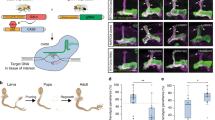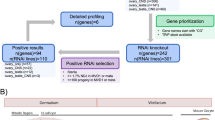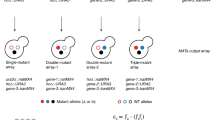Abstract
RNA interference (RNAi)-mediated loss-of-function screening in Drosophila melanogaster tissue culture cells is a powerful method for identifying the genes underlying cell biological functions and for annotating the fly genome. Here we describe the development of living-cell microarrays for screening large collections of RNAi-inducing double-stranded RNAs (dsRNAs) in Drosophila cells. The features of the microarrays consist of clusters of cells 200 μm in diameter, each with an RNAi-mediated depletion of a specific gene product. Because of the small size of the features, thousands of distinct dsRNAs can be screened on a single chip. The microarrays are suitable for quantitative and high-content cellular phenotyping and, in combination screens, for the identification of genetic suppressors, enhancers and synthetic lethal interactions. We used a prototype cell microarray with 384 different dsRNAs to identify previously unknown genes that affect cell proliferation and morphology, and, in a combination screen, that regulate dAkt/dPKB phosphorylation in the absence of dPTEN expression.
This is a preview of subscription content, access via your institution
Access options
Subscribe to this journal
Receive 12 print issues and online access
$259.00 per year
only $21.58 per issue
Buy this article
- Purchase on Springer Link
- Instant access to full article PDF
Prices may be subject to local taxes which are calculated during checkout




Similar content being viewed by others
References
Clemens, J.C. et al. Use of double-stranded RNA interference in Drosophila cell lines to dissect signal transduction pathways. Proc. Natl. Acad. Sci. USA 97, 6499–6503 (2000).
Lum, L. et al. Identification of Hedgehog pathway components by RNAi in Drosophila cultured cells. Science 299, 2039–2045 (2003).
Kiger, A. et al. A functional genomic analysis of cell morphology using RNA interference. J. Biol. 2, 27 (2003).
Foley, E. & O'Farrell, P.H. Functional dissection of an innate immune response by a genome-wide RNAi screen. PLoS Biol. 2, E203 (2004).
Boutros, M. et al. Genome-wide RNAi analysis of growth and viability in Drosophila cells. Science 303, 832–835 (2004).
Ziauddin, J. & Sabatini, D.M. Microarrays of cells expressing defined cDNAs. Nature 411, 107–110 (2001).
Baghdoyan, S. et al. Quantitative analysis of highly parallel transfection in cell microarrays. Nucleic Acids Res. 32, e77 (2004).
Mousses, S. et al. RNAi microarray analysis in cultured mammalian cells. Genome Res. 13, 2341–2347 (2003).
Silva, J.M., Mizuno, H., Brady, A., Lucito, R. & Hannon, G.J. RNA interference microarrays: high-throughput loss-of-function genetics in mammalian cells. Proc. Natl. Acad. Sci. USA 101, 6548–6552 (2004).
Yoshikawa, T. et al. Transfection microarray of human mesenchymal stem cells and on-chip siRNA gene knockdown. J. Control. Release 96, 227–232 (2004).
Hay, B.A., Wassarman, D.A. & Rubin, G.M. Drosophila homologs of baculovirus inhibitor of apoptosis proteins function to block cell death. Cell 83, 1253–1262 (1995).
Igaki, T., Yamamoto-Goto, Y., Tokushige, N., Kanda, H. & Miura, M. Down-regulation of DIAP1 triggers a novel Drosophila cell death pathway mediated by Dark and DRONC. J. Biol. Chem. 277, 23103–23106 (2002).
Smith, A., Alrubaie, S., Coehlo, C., Leevers, S.J. & Ashworth, A. Alternative splicing of the Drosophila PTEN gene. Biochim. Biophys. Acta 1447, 313–317 (1999).
Goberdhan, D.C., Paricio, N., Goodman, E.C., Mlodzik, M. & Wilson, C. Drosophila tumor suppressor PTEN controls cell size and number by antagonizing the Chico/PI3-kinase signaling pathway. Genes Dev. 13, 3244–3258 (1999).
Huang, H. et al. PTEN affects cell size, cell proliferation and apoptosis during Drosophila eye development. Development 126, 5365–5372 (1999).
Echalier, G. & Ohanessian, A. In vitro culture of Drosophila melanogaster embryonic cells. In Vitro 6, 162–172 (1970).
Yanagawa, S., Lee, J.S. & Ishimoto, A. Identification and characterization of a novel line of Drosophila Schneider S2 cells that respond to wingless signaling. J. Biol. Chem. 273, 32353–32359 (1998).
Dorstyn, L., Colussi, P.A., Quinn, L.M., Richardson, H. & Kumar, S. DRONC, an ecdysone-inducible Drosophila caspase. Proc. Natl. Acad. Sci. USA 96, 4307–4312 (1999).
Li, X., Scuderi, A., Letsou, A. & Virshup, D.M. B56-associated protein phosphatase 2A is required for survival and protects from apoptosis in Drosophila melanogaster. Mol. Cell. Biol. 22, 3674–3684 (2002).
Silverstein, A.M., Barrow, C.A., Davis, A.J. & Mumby, M.C. Actions of PP2A on the MAP kinase pathway and apoptosis are mediated by distinct regulatory subunits. Proc. Natl. Acad. Sci. USA 99, 4221–4226 (2002).
Haruta, T. et al. A rapamycin-sensitive pathway down-regulates insulin signaling via phosphorylation and proteasomal degradation of insulin receptor substrate-1. Mol. Endocrinol. 14, 783–794 (2000).
Radimerski, T., Montagne, J., Hemmings-Mieszczak, M. & Thomas, G. Lethality of Drosophila lacking TSC tumor suppressor function rescued by reducing dS6K signaling. Genes Dev. 16, 2627–2632 (2002).
Radimerski, T. et al. dS6K-regulated cell growth is dPKB/dPI(3)K-independent, but requires dPDK1. Nat. Cell Biol. 4, 251–255 (2002).
Acknowledgements
This work was supported by funds from the Whitehead Institute, the Pew Charitable Trust to D.M.S., a Damon Runyon Fellowship to D.A.G. and a Computational and Systems Biology Initiative/Merck/MIT Fellowship to A.E.C. We thank C. Thoreen for technical help, T.R. Jones for software advice and data mining and M. Boutros for helpful discussions.
Author information
Authors and Affiliations
Corresponding author
Ethics declarations
Competing interests
The authors declare no competing financial interests.
Supplementary information
Supplementary Fig. 1
Drosophila RNAi cell microarrays made with DIAP1 and dPTEN dsRNAs printed over a wide concentration range. (PDF 64 kb)
Supplementary Fig. 2
RNAi cell microarrays made with spots printed with a mixture of two dsRNAs. (PDF 106 kb)
Supplementary Table 1
Cell count, average nuclear area, and phospho-dAkt intensity of cells growing on spots printed with dsRNAs corresponding to indicated genes. The “Cell Count” column indicates the number of cells on each spot as determined with Hoechst staining. The “Average Nuclear Area” column indicates the average area of the nuclei of the cells on each spot and is presented in arbitrary units. Values have been normalized to the average nuclear area of the cells growing on the spots printed with the GFP dsRNA. “P-dAkt Intensity” indicates for each dsRNA spot the total intensity, normalized to cell number, of the immunofluorescent signal obtained with a phospho-dAkt antibody. Values are presented in arbitrary units and are shown for both control cells or for cells that had been transfected 48 hours earlier with the dPTEN dsRNA. (PDF 43 kb)
Supplementary Table 2
Comparison of cell number measurements of genes listed in Fig. 3e with cell viability measurements for those genes also tested by Boutros et al.5 (Science 303, 832–835; 2004). Of the 44 genes affecting cell number, 28 were also tested in the viability screen5 and of these 9 (32%) genes affected cell viability. Of the 340 genes not affecting cell number, 203 were also tested in the viability screen and, of these, 1 (0.5%) gene affected cell viability. Interestingly, most of the genes with the greatest effects on cell number also scored in the viability screen. The “Viability Hit?” column indicates if the gene was identified in the Kc167 or S2R+ viability screen and the “z-score” column the corresponding the z-score (a positive z-score means less ATP content). Other column headings are as in Supplementary Table 1. The middle part of the table between the single and double lines lists genes that were hits in our cell number screen but were not tested in the viability screen. The lower part of the table below the double line lists the results for the single gene that scored in the viability but not the cell number screen. The viability data was extracted from flyrnai.org or through the examination of the charts and tables in Boutros et al.5. (PDF 18 kb)
Rights and permissions
About this article
Cite this article
Wheeler, D., Bailey, S., Guertin, D. et al. RNAi living-cell microarrays for loss-of-function screens in Drosophila melanogaster cells. Nat Methods 1, 127–132 (2004). https://doi.org/10.1038/nmeth711
Received:
Accepted:
Published:
Issue Date:
DOI: https://doi.org/10.1038/nmeth711
This article is cited by
-
Synthetic lethal interaction between oxidative stress response and DNA damage repair in the budding yeast and its application to targeted anticancer therapy
Journal of Microbiology (2019)
-
Application of cellular micropatterns to miniaturized cell-based biosensor
Biomedical Engineering Letters (2013)
-
Ex Vivo Gene Delivery to Hepatocytes: Techniques, Challenges, and Underlying Mechanisms
Annals of Biomedical Engineering (2012)
-
Layer-by-layer assembly of small interfering RNA and poly(ethyleneimine) for substrate-mediated electroporation with high efficiency
Analytical and Bioanalytical Chemistry (2010)



